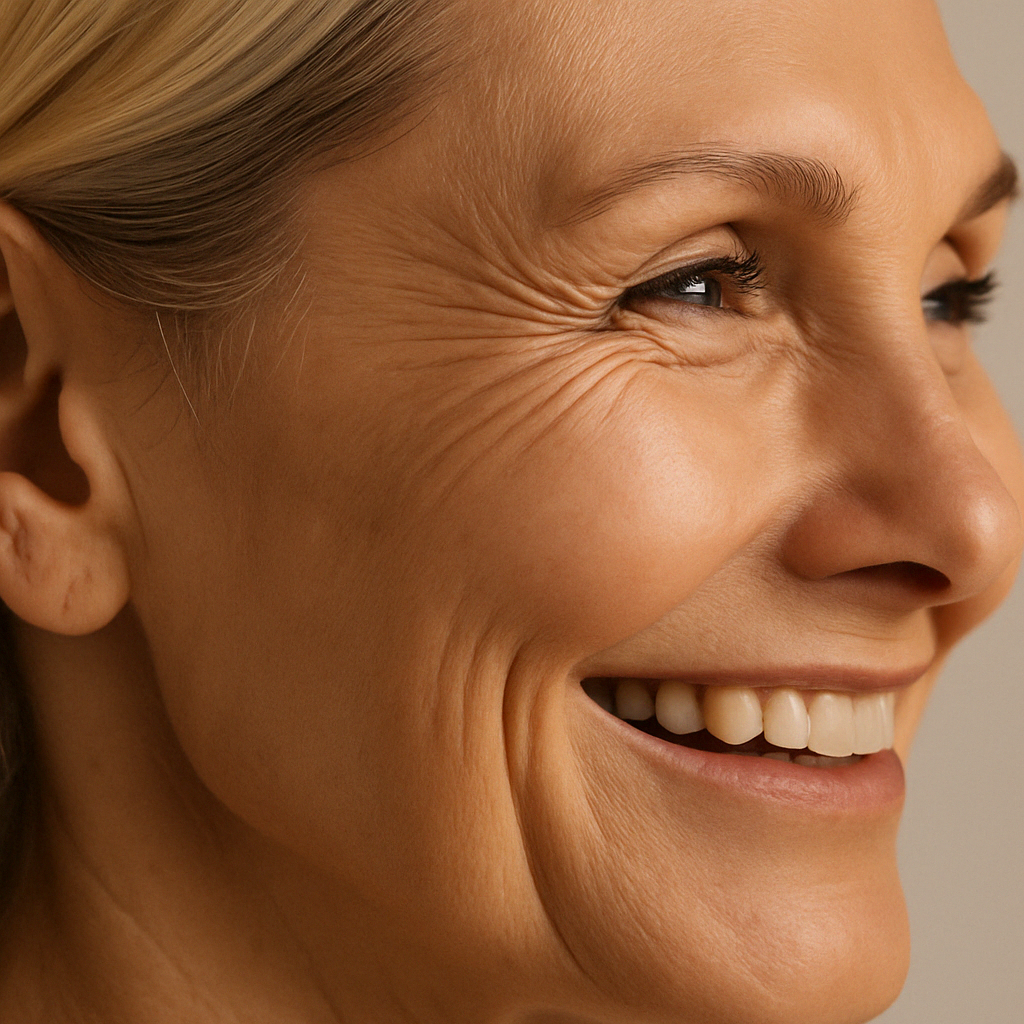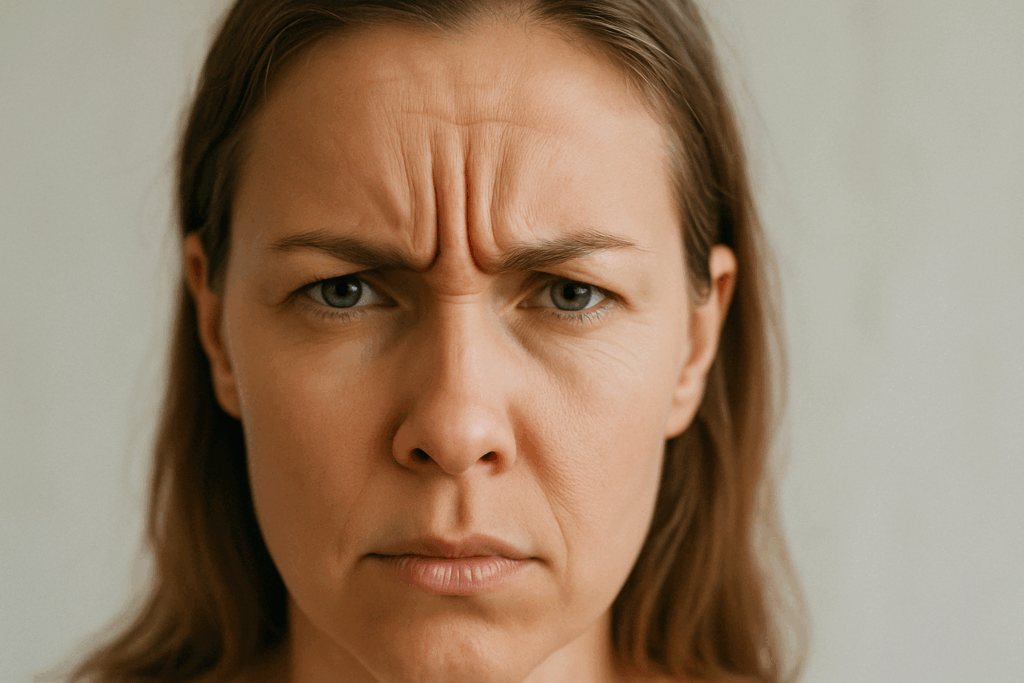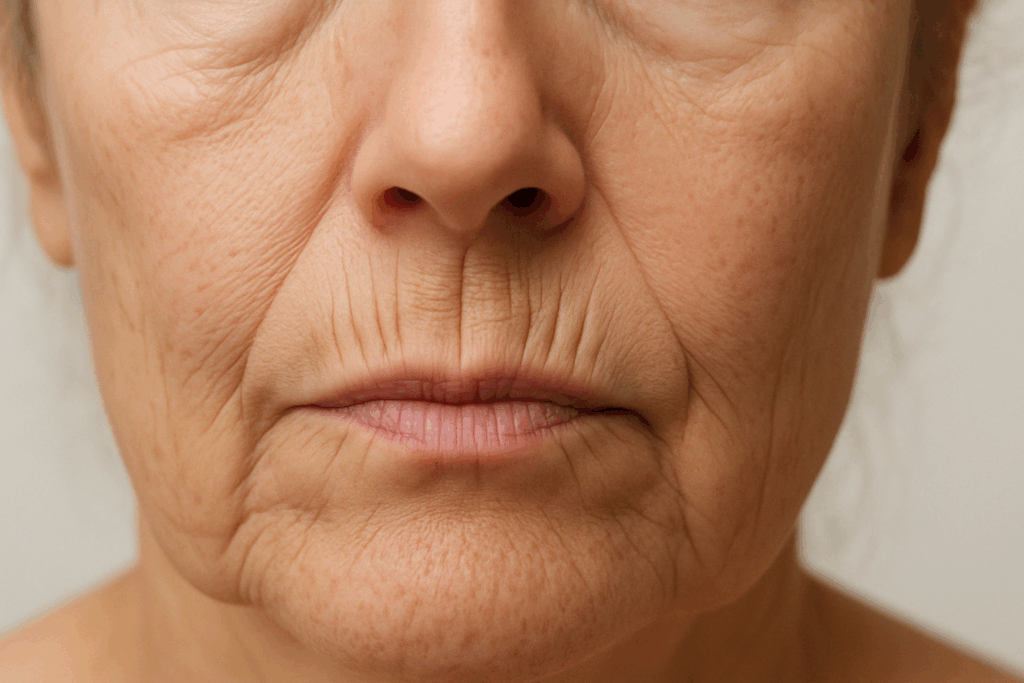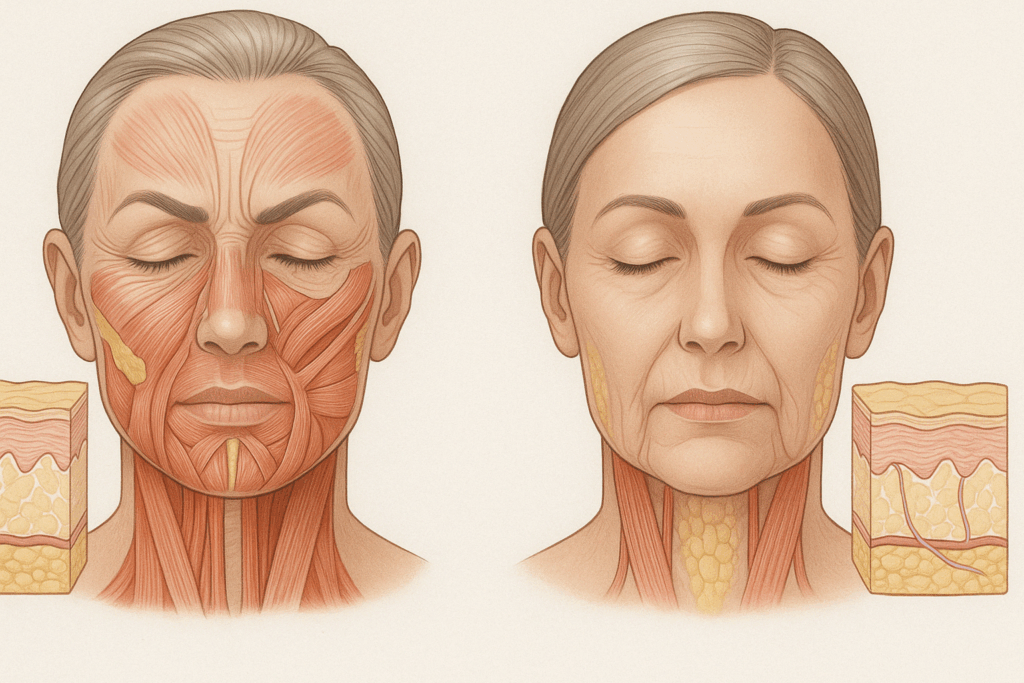As the skin matures, it tells a silent but intricate story—one etched in fine lines, furrows, and folds that speak to a lifetime of expressions, environmental exposure, and biological evolution. These physical changes, often referred to collectively as wrinkles, are more than superficial signs of aging. They are clinical markers that offer insights into the health of the skin, the dynamics of facial movement, and the overall aging process. To fully appreciate how and why these lines emerge, it is essential to understand the various types of face wrinkles and the specific names that categorize them. These terms are not merely cosmetic descriptors; they reflect deeper anatomical, physiological, and environmental influences. By exploring the science and nomenclature behind the different types of facial wrinkles, we can better understand not only how skin ages but also how to prevent or reduce these changes with evidence-based care.
You may also like: How to Choose Skin Care for Fine Lines: Evidence-Based Tips for Healthier, Younger-Looking Skin
Wrinkles are broadly categorized into two main types: dynamic and static. Dynamic wrinkles form as a result of repeated muscle movement, typically emerging in younger individuals during facial expressions such as smiling, frowning, or squinting. These are the lines that come and go based on facial activity, but over time, as collagen and elastin fibers degrade and the skin loses its ability to bounce back, dynamic wrinkles can evolve into static wrinkles—lines that remain etched into the skin regardless of expression. Static wrinkles deepen with age and are influenced by intrinsic aging factors such as genetics and hormonal changes, as well as extrinsic factors like sun exposure, smoking, and air pollution. Understanding these categories is crucial because it informs both clinical diagnosis and treatment approaches. For instance, dynamic wrinkles often respond well to neuromodulators like botulinum toxin, while static wrinkles may require dermal fillers, resurfacing procedures, or long-term topical therapies.

One of the most recognizable names of wrinkles on the face is the term “crow’s feet.” These fine lines radiate from the outer corners of the eyes and are among the earliest to appear, often due to the delicate nature of the periorbital skin. The area around the eyes is thinner and lacks sebaceous glands, making it more susceptible to dehydration and creasing. Crow’s feet are primarily dynamic wrinkles, triggered by the orbicularis oculi muscle during smiling or squinting. Over time, however, they may become static due to repetitive use and environmental damage. Prevention strategies include consistent use of broad-spectrum sunscreen, protective eyewear, and targeted skincare formulations rich in peptides and antioxidants. Clinical interventions may range from botulinum toxin injections to fractionated laser therapy, each aiming to relax the muscle or rebuild lost collagen in the affected area.
Another widely recognized wrinkle type is the nasolabial fold—often mistakenly referred to as a wrinkle, though it is technically a facial crease. These are the deep lines that extend from the sides of the nose to the corners of the mouth. While they are a natural anatomical feature, they tend to become more pronounced with age due to mid-face volume loss, gravitational changes, and repetitive facial movements. Unlike crow’s feet, nasolabial folds are less about muscle contraction and more about structural support. Treatment for these lines often includes dermal fillers composed of hyaluronic acid or collagen-stimulating agents to restore volume and lift the area. Early interventions may also focus on maintaining skin elasticity through lifestyle choices and consistent skincare.

Forehead wrinkles are another prevalent category that falls under both dynamic and static classifications. Horizontal forehead lines result primarily from the repeated activation of the frontalis muscle, often associated with raising the eyebrows. These lines tend to appear earlier in individuals with expressive faces or those who frequently engage in eyebrow-lifting expressions. Vertical lines between the eyebrows, known as glabellar lines or “frown lines,” are caused by the corrugator and procerus muscles. The names of wrinkles on the face in this region are often used clinically to guide botulinum toxin placement. Over time, both horizontal and vertical lines can become deeply ingrained, particularly in individuals with sun-damaged or dehydrated skin. Treatment protocols may include neurotoxin injections to paralyze the overactive muscles, alongside resurfacing treatments or retinoid-based topical regimens.
Marionette lines, which run from the corners of the mouth downward toward the chin, create a downturned appearance that can convey sadness or fatigue, even when the individual is at rest. These lines often form as a result of both volume loss and skin laxity in the lower face, making them more static in nature. The types of face wrinkles that develop in this area are influenced not only by facial expressions but also by age-related changes in bone density and fat redistribution. Effective treatment requires a multifactorial approach, often combining dermal fillers with skin-tightening technologies like radiofrequency or ultrasound-based therapies. Long-term prevention also involves strategies that support dermal integrity, including adequate hydration, balanced nutrition, and avoidance of smoking and excessive sun exposure.

Bunny lines, which appear on the sides of the nose when a person smiles or scrunches their face, are lesser-known but increasingly recognized in aesthetic dermatology. These are dynamic wrinkles caused by the action of the nasalis muscle and are often more prominent in individuals who have undergone repeated botulinum toxin injections in other areas of the face. The displacement of muscular activity can cause compensatory overuse of surrounding muscles, resulting in the formation of new wrinkles. While bunny lines are generally not considered a significant aesthetic concern, they can be treated with low-dose neurotoxin to balance facial musculature. Preventing overuse of specific muscles and ensuring a holistic approach to facial aesthetics is essential for avoiding secondary wrinkle development.

Another frequently overlooked area is the perioral region, where fine vertical lines above the upper lip—commonly referred to as “lipstick lines” or “smoker’s lines”—tend to form. These types of face wrinkles are influenced by repetitive puckering movements, often from smoking or using straws, as well as by the natural decline in collagen and elastin. The skin in this area is thin and particularly vulnerable to photodamage, making sun protection a crucial preventive measure. Advanced treatment options may include resurfacing lasers, microneedling with platelet-rich plasma, or injectable biostimulants that promote collagen regeneration. Regular use of retinoids and hydrating serums can also mitigate the progression of these lines.

Neck wrinkles, though not strictly on the face, are increasingly considered in comprehensive anti-aging strategies. The horizontal lines on the neck, sometimes referred to as “tech neck,” arise from frequent downward glancing at screens and devices. These lines are compounded by skin laxity and thinning in the cervical region, which lacks the structural support found in facial musculature. Because this area is often neglected in skincare routines, it becomes a prime location for early wrinkling. Addressing neck wrinkles involves extending facial skincare products to the décolletage, practicing ergonomic posture, and considering non-invasive treatments such as ultrasound therapy or injectable skin boosters. As awareness grows, the inclusion of neck care in anti-aging protocols is becoming a standard recommendation among dermatologists and cosmetic professionals.
The classification and naming of facial wrinkles are not just matters of terminology; they serve critical roles in clinical assessment, treatment planning, and patient education. Understanding the names of wrinkles on the face allows practitioners to communicate more effectively with patients and tailor treatments to specific anatomical zones. For example, knowing whether a wrinkle is primarily dynamic or static guides the selection of interventions—neuromodulators versus fillers versus resurfacing therapies. Moreover, patients who understand the types of face wrinkles they are developing are more likely to adopt preventive measures and engage in consistent skincare practices.

Psychologically, the visibility and location of facial wrinkles can affect self-esteem and mental well-being. Studies have shown that certain facial lines—particularly those associated with negative expressions like frowning or sadness—can influence how others perceive an individual’s mood or temperament. This phenomenon, often referred to as “resting face bias,” highlights the intersection of dermatological health and psychological wellness. Addressing facial wrinkles, therefore, is not merely a cosmetic endeavor but a holistic one that encompasses emotional, social, and cognitive dimensions. For some individuals, aesthetic treatments can lead to significant improvements in confidence and quality of life, especially when guided by ethical, medically sound principles.
From a preventive standpoint, the most effective strategies are those grounded in evidence-based skincare and lifestyle habits. Daily use of sunscreen with broad-spectrum protection is universally recommended by dermatologists to prevent both premature aging and skin cancer. Antioxidants such as vitamin C and E, when applied topically, help combat oxidative stress that contributes to wrinkle formation. Retinoids, derived from vitamin A, remain the gold standard in topical anti-aging treatment, as they stimulate collagen production and promote cellular turnover. Hydration, both internal and external, plays a pivotal role in maintaining skin elasticity and volume. Adequate water intake, combined with humectant-rich moisturizers containing hyaluronic acid or glycerin, can significantly enhance skin texture and resilience.
Nutrition also exerts a profound influence on skin health. Diets rich in omega-3 fatty acids, antioxidants, and phytonutrients support dermal repair mechanisms and reduce inflammation. Conversely, diets high in sugar and processed foods may accelerate glycation, a process that damages collagen and elastin fibers. Regular physical activity improves circulation, which in turn delivers oxygen and nutrients to the skin, promoting a youthful appearance. Sleep, often underestimated, is another cornerstone of skin health. During deep sleep cycles, the body releases growth hormones that facilitate tissue repair, including the regeneration of skin cells. Establishing a consistent sleep routine and managing stress levels can therefore have a visible impact on the aging process.
In the evolving field of aesthetic medicine, technological innovations continue to expand the arsenal of treatments available for wrinkle prevention and correction. Non-invasive modalities such as radiofrequency microneedling, fractional CO2 lasers, and high-intensity focused ultrasound (HIFU) offer significant improvements in skin texture and firmness without extensive downtime. Injectable therapies now include not only traditional fillers and neuromodulators but also biostimulatory agents that enhance the skin’s intrinsic repair mechanisms. Advances in personalized skincare, informed by genetic testing and microbiome analysis, are paving the way for more targeted and effective anti-aging interventions. While these technologies hold promise, they are most effective when integrated into a comprehensive approach that includes healthy lifestyle practices and informed self-care.
Ultimately, the study of wrinkles is a reflection of broader themes in dermatology, psychology, and preventive medicine. Each line on the face tells a story—not just of aging, but of expression, resilience, and adaptation. Recognizing the different types of face wrinkles and understanding what the names of wrinkles on the face signify allows us to approach aging with both scientific insight and compassionate care. In doing so, we move beyond superficial aesthetics to embrace a more nuanced and empowering vision of health and beauty.
Frequently Asked Questions: Understanding the Types and Names of Face Wrinkles
1. Can your sleeping position influence the types of face wrinkles you develop?
Yes, your habitual sleeping posture can contribute significantly to the development of specific types of face wrinkles. Repeated pressure on the same areas of the face—such as sleeping on your side or stomach—can cause compression lines that deepen over time. These sleep-induced wrinkles often appear on the cheeks, chin, or forehead, and are usually static in nature. Interestingly, they do not follow the natural muscle movement patterns seen in dynamic wrinkles. Although these aren’t commonly named wrinkles on the face like crow’s feet or frown lines, they are increasingly being recognized as a category influenced by mechanical stress and can be mitigated with the use of silk pillowcases or back-sleeping techniques.
2. How does facial anatomy contribute to the names of wrinkles on the face?
Facial anatomy plays a vital role in how the names of wrinkles on the face are derived and categorized. Many wrinkle names correspond to the underlying facial muscles responsible for their formation. For example, glabellar lines are directly linked to the action of the corrugator and procerus muscles. Moreover, the depth and direction of these wrinkles are often influenced by bone structure and fat distribution, which can vary widely between individuals. This anatomical precision helps dermatologists and aesthetic practitioners customize treatment plans based on the specific types of face wrinkles present in each zone.
3. Are there cultural or ethnic differences in the types of face wrinkles that appear more prominently?
Absolutely—ethnic background and skin type can influence both the onset and presentation of different types of face wrinkles. For instance, individuals with more melanin-rich skin tend to develop wrinkles later due to increased natural protection against ultraviolet (UV) damage. However, when wrinkles do occur, they may manifest more as folds than fine lines, due to the unique collagen architecture. Additionally, some names of wrinkles on the face may be more commonly referenced in Western dermatology than in Eastern practices, which may emphasize other aging signs such as pigment irregularities or puffiness. Understanding these distinctions is crucial in providing equitable, effective skincare and treatment options across diverse populations.
4. What role does facial yoga or resistance training play in wrinkle prevention?
Facial yoga and resistance training aim to tone the underlying facial muscles to enhance firmness and circulation, potentially delaying the onset of certain types of face wrinkles. While scientific research is still emerging, preliminary studies and anecdotal reports suggest these techniques may improve muscle volume and reduce skin laxity. For example, targeted exercises could hypothetically reduce the visibility of marionette lines by lifting the cheek area. However, overuse or improper technique might also contribute to new dynamic wrinkles if certain muscles become overactivated. While not a cure-all, facial exercises offer a non-invasive approach to complement other wrinkle-prevention strategies, especially for those aware of the different names of wrinkles on the face and seeking personalized care.
5. Can artificial intelligence help detect and classify types of face wrinkles more accurately?
Yes, advances in artificial intelligence (AI) are transforming how clinicians identify and categorize the types of face wrinkles. AI tools can now analyze high-resolution facial images to map out wrinkle patterns and predict aging trajectories based on individual facial dynamics. These systems use machine learning algorithms trained on thousands of faces, enabling more precise differentiation between wrinkle types and their likely causes. This could even refine our understanding of the names of wrinkles on the face by creating new subcategories or redefining existing ones with greater nuance. In the future, such technology may allow for hyper-personalized treatment plans and earlier, more targeted interventions.
6. How do environmental pollutants impact the formation of specific types of face wrinkles?
Environmental pollutants like particulate matter, ozone, and nitrogen dioxide can accelerate the development of various types of face wrinkles, particularly in exposed regions like the forehead, cheeks, and periorbital area. These pollutants generate free radicals that degrade collagen and elastin, leading to premature skin aging. In some studies, people living in highly urbanized areas showed deeper and more complex wrinkle formations, even when sun exposure was controlled for. The interaction between pollution and UV radiation can further exacerbate wrinkle depth and visibility. Although the names of wrinkles on the face remain constant, the speed and severity of their development are clearly influenced by environmental stressors, making pollution control an emerging frontier in skin aging research.
7. Are the names of wrinkles on the face standardized across medical literature?
While many wrinkle names are widely recognized—such as crow’s feet, frown lines, or nasolabial folds—there is no universally standardized naming system in medical literature. Some dermatological texts rely on anatomical references, while aesthetic practitioners may prefer more colloquial terms that are easier for patients to understand. Additionally, new types of face wrinkles are continually being described as aesthetic science evolves, such as “tech neck” wrinkles or “accordion lines.” This variability can create confusion but also allows flexibility in tailoring communication based on the audience, whether clinical or consumer. Greater consensus may emerge as digital imaging and diagnostic software become more prevalent in practice.
8. How does hormonal fluctuation affect the development of certain types of face wrinkles?
Hormonal changes—particularly in estrogen and cortisol levels—can influence how and when certain types of face wrinkles appear. Estrogen, for instance, plays a critical role in collagen synthesis and skin hydration. As levels decline during menopause, skin tends to become thinner, drier, and less elastic, accelerating the formation of static wrinkles such as marionette lines and nasolabial folds. Cortisol, the stress hormone, can break down connective tissue over time, contributing to wrinkle formation even in younger individuals. Understanding how hormonal cycles interact with the names of wrinkles on the face could open the door to more precise preventive strategies, including hormone replacement therapy and stress management protocols.
9. What are the psychological effects of recognizing specific wrinkle patterns on the face?
The psychological effects of facial wrinkles extend beyond vanity—they can significantly influence self-perception, emotional expression, and social interaction. Some individuals may become hyper-aware of specific types of face wrinkles, interpreting them as signs of fatigue, sadness, or aging, even when they don’t feel that way internally. For instance, the presence of deep glabellar lines may be misread by others as anger or frustration, affecting interpersonal dynamics. Moreover, becoming familiar with the names of wrinkles on the face can either empower individuals to seek appropriate care or contribute to increased anxiety if misinterpreted. Balancing awareness with self-compassion is key to maintaining mental and emotional well-being in the context of visible aging.
10. What emerging treatments target less common types of face wrinkles?
Emerging treatments are now targeting niche types of face wrinkles that were previously overlooked in mainstream aesthetic care. For example, injectable biostimulators and polynucleotides are being explored for subtle, fine-line corrections in areas like the temples or earlobes. Additionally, regenerative approaches such as exosome therapy and stem-cell-derived serums are showing promise in addressing micro-wrinkles that don’t fall under commonly recognized names of wrinkles on the face. These techniques work at a cellular level to repair and renew skin tissue rather than simply filling or relaxing existing lines. As innovation continues, the industry is moving toward more nuanced solutions that honor the individuality of every wrinkle pattern—regardless of how well known its name may be.
Reflecting on Wrinkle Types and Skin Aging: What the Names of Facial Lines Teach Us About Prevention and Well-Being
The names of wrinkles on the face may seem like cosmetic jargon, but they encapsulate a wealth of information about how the skin ages, responds to movement, and interacts with our environment. These terms help classify the types of face wrinkles based on their location, origin, and depth—each of which carries implications for both treatment and prevention. Crow’s feet, marionette lines, glabellar furrows, and nasolabial folds are not just aesthetic concerns; they are dynamic records of the skin’s history and a mirror to our lived experiences. By understanding their physiological underpinnings and contributing lifestyle factors, we become better equipped to make informed decisions about skincare, sun protection, and professional treatment options.
Moreover, the language of wrinkles empowers both patients and practitioners. It enhances communication, facilitates early intervention, and promotes realistic expectations about aging and self-image. In recognizing the diversity and complexity of facial lines, we shift away from stigma and toward a narrative of informed care. Prevention, after all, is not just about aesthetics—it’s about preserving the skin’s function, comfort, and health throughout the lifespan. As we continue to unravel the science of skin aging, the integration of dermatological expertise, lifestyle medicine, and psychological insight will remain essential in promoting holistic well-being at every age.
Was this article helpful? Don’t let it stop with you. Share it right now with someone who needs to see it—whether it’s a friend, a colleague, or your whole network. And if staying ahead on this topic matters to you, subscribe to this publication for the most up-to-date information. You’ll get the latest insights delivered straight to you—no searching, no missing out
Further Reading:
Wrinkles & Fine Lines: Types, Causes & Prevention
Decoding What These 7 Wrinkle Types Might Say About You
Wrinkles: Causes, treatment, and prevention
Disclaimer :
The information contained in this article is provided for general informational purposes only and is not intended to serve as medical, legal, or professional advice. While Health11News strives to present accurate, up-to-date, and reliable content, no warranty or guarantee, expressed or implied, is made regarding the completeness, accuracy, or adequacy of the information provided. Readers are strongly advised to seek the guidance of a qualified healthcare provider or other relevant professionals before acting on any information contained in this article. Health11News, its authors, editors, and contributors expressly disclaim any liability for any damages, losses, or consequences arising directly or indirectly from the use, interpretation, or reliance on any information presented herein. The views and opinions expressed in this article are those of the author(s) and do not necessarily reflect the official policies or positions of Health11News.